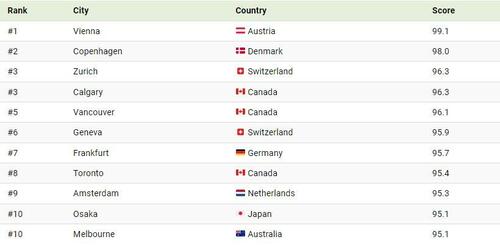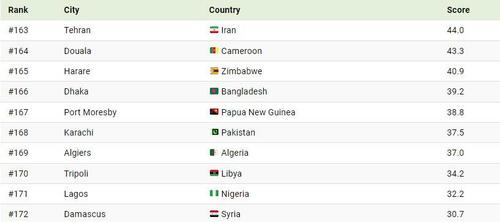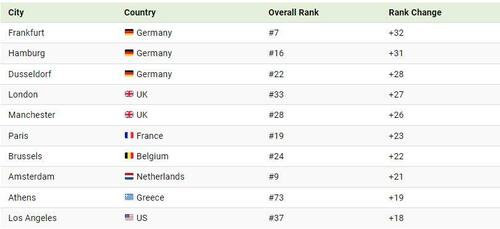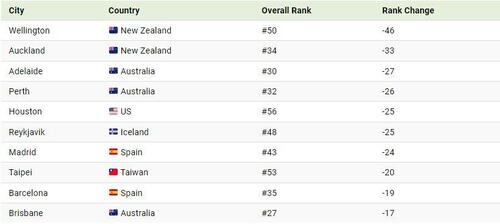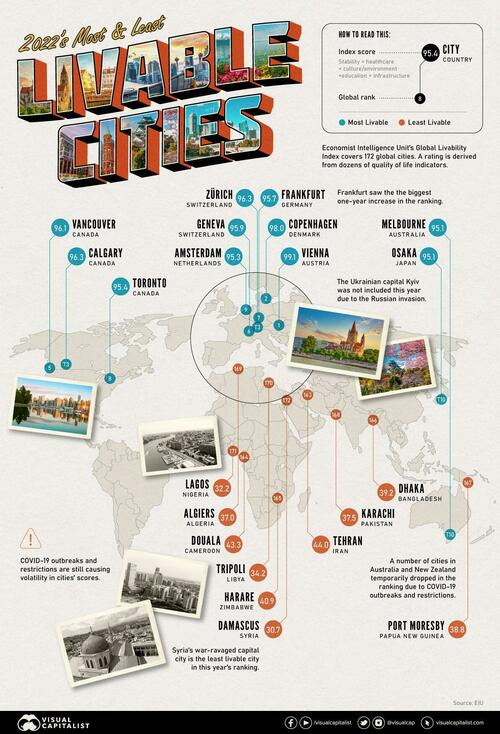
Pandemic restrictions changed the livability of many urban centers worldwide as cultural sites were shuttered, restaurant dining was restricted, and local economies faced the consequences. But as cities worldwide return to the status quo, many of these urban centers have become desirable places to live yet again.
As Visual Capitalist's Avery Koop notes, this map uses annual rankings from the Economist Intelligence Unit (EIU) to show the world’s most livable cities, measuring different categories including: stability, healthcare, culture and environment, education, and infrastructure.
A Quick Note on Methodology
The ranking attempts to assess which cities across the globe provide the best living conditions, by assigning a score on 30 quantitative and qualitative measures across the five categories with the following weightings:
- Healthcare (20%)
- Culture & Environment (25%)
- Stability (25%)
- Education (10%)
- Infrastructure (20%)
Of the 30 factors within these categories, the qualitative ones are assigned as acceptable, tolerable, uncomfortable, undesirable, or intolerable by a team of expert analysts. Quantitative measures are given a score based on a number of external data points. Everything is then weighted to provide a score between 1-100, with 100 being the ideal.
Ranked: The 10 Most Livable Cities
Of the 172 cities included in the rankings, many of the most livable cities can be found in Europe. However, three of the top 10 are located in Canada: Vancouver, Calgary, and Toronto.
Vienna has been ranked number one many times, most recently in 2019. According to the EIU, the Austrian capital only fell out of the top slot during the pandemic years because its famous museums and restaurants were shuttered.
Only one Asian city, Osaka, makes the top 10 list, tying with Melbourne for 10th place. Notably, not a single U.S. city is found in the top ranks.
Editor’s note: Two cities tie for both the #3 and #10 ranks, meaning that the “top 10” list actually includes 12 cities.
Ranked: The 10 Least Livable Cities
Some of the least livable cities in the world are located across Africa and Central Asia.
Many of the least livable cities are within conflict zones, contributing to the low ratings. However, these regions are also home to some of the world’s fastest growing cities, presenting many opportunities for ambitious residents.
The Biggest Changes in Ranking
Let’s take a look at the cities that moved up the global rankings most dramatically compared to last year’s data.
Moving Up: The 10 Most Improved Cities
Here’s a look at the cities that fell the most in the rankings since last year’s report.
Moving Down: The 10 Cities That Tumbled
According to the report, a number of cities in New Zealand and Australia temporarily dropped in the ranking due to COVID-19 restrictions.
It’s also worth noting that some Eastern European cities moved down in the rankings because of their close proximity to the war in Ukraine. Finally, Kyiv was not included in this year’s report because of the conflict.
Urbanization and Livability
As of 2021, around 57% of the world’s population lives in urban centers and projections show that people worldwide will continue to move into cities.
While there are more amenities in urban areas, the pandemic revealed many issues with urbanization and the concentration of large populations. The stress on healthcare systems is felt most intensely in cities and restrictions on public outings are some of the first measures to be introduced in the face of a global health crisis.
Now with the cost of living rising, cities may face pressures on their quality of life, and governments may be forced to cut spending on public services. Regardless, people worldwide continue to see the benefits of city living—it’s projected that over two-thirds of the global population will live in cities by 2050.
Pandemic restrictions changed the livability of many urban centers worldwide as cultural sites were shuttered, restaurant dining was restricted, and local economies faced the consequences. But as cities worldwide return to the status quo, many of these urban centers have become desirable places to live yet again.
As Visual Capitalist’s Avery Koop notes, this map uses annual rankings from the Economist Intelligence Unit (EIU) to show the world’s most livable cities, measuring different categories including: stability, healthcare, culture and environment, education, and infrastructure.
A Quick Note on Methodology
The ranking attempts to assess which cities across the globe provide the best living conditions, by assigning a score on 30 quantitative and qualitative measures across the five categories with the following weightings:
- Healthcare (20%)
- Culture & Environment (25%)
- Stability (25%)
- Education (10%)
- Infrastructure (20%)
Of the 30 factors within these categories, the qualitative ones are assigned as acceptable, tolerable, uncomfortable, undesirable, or intolerable by a team of expert analysts. Quantitative measures are given a score based on a number of external data points. Everything is then weighted to provide a score between 1-100, with 100 being the ideal.
Ranked: The 10 Most Livable Cities
Of the 172 cities included in the rankings, many of the most livable cities can be found in Europe. However, three of the top 10 are located in Canada: Vancouver, Calgary, and Toronto.
Vienna has been ranked number one many times, most recently in 2019. According to the EIU, the Austrian capital only fell out of the top slot during the pandemic years because its famous museums and restaurants were shuttered.
Only one Asian city, Osaka, makes the top 10 list, tying with Melbourne for 10th place. Notably, not a single U.S. city is found in the top ranks.
Editor’s note: Two cities tie for both the #3 and #10 ranks, meaning that the “top 10” list actually includes 12 cities.
Ranked: The 10 Least Livable Cities
Some of the least livable cities in the world are located across Africa and Central Asia.
Many of the least livable cities are within conflict zones, contributing to the low ratings. However, these regions are also home to some of the world’s fastest growing cities, presenting many opportunities for ambitious residents.
The Biggest Changes in Ranking
Let’s take a look at the cities that moved up the global rankings most dramatically compared to last year’s data.
Moving Up: The 10 Most Improved Cities
Here’s a look at the cities that fell the most in the rankings since last year’s report.
Moving Down: The 10 Cities That Tumbled
According to the report, a number of cities in New Zealand and Australia temporarily dropped in the ranking due to COVID-19 restrictions.
It’s also worth noting that some Eastern European cities moved down in the rankings because of their close proximity to the war in Ukraine. Finally, Kyiv was not included in this year’s report because of the conflict.
Urbanization and Livability
As of 2021, around 57% of the world’s population lives in urban centers and projections show that people worldwide will continue to move into cities.
While there are more amenities in urban areas, the pandemic revealed many issues with urbanization and the concentration of large populations. The stress on healthcare systems is felt most intensely in cities and restrictions on public outings are some of the first measures to be introduced in the face of a global health crisis.
Now with the cost of living rising, cities may face pressures on their quality of life, and governments may be forced to cut spending on public services. Regardless, people worldwide continue to see the benefits of city living—it’s projected that over two-thirds of the global population will live in cities by 2050.
